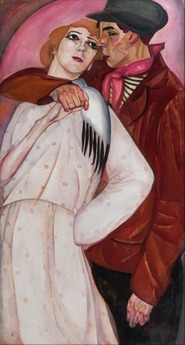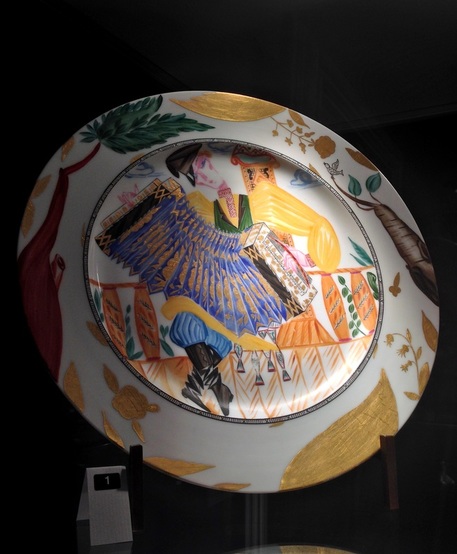REVIEW: Russian Portraits of the 18th – 20th Centuries, St Petersburg Gallery
Above: Lomonosov Porcelain Factory, Platter ‘Accordionist’, porcelain, 1923 / Courtesy of Anna Prosvetova
It is easy to get lost in the variety of exhibitions London cultural scene presents to an art enthusiast. Being attracted to blockbuster shows, one could easily overlook exhibitions, which might be smaller in scale, but not at all in quality of works. Russian portraits of the 18th-20th centuries at St. Petersburg Gallery is a good example, exploring may be the most personal genre in art through works, created in different periods of Russian history. Showing paintings, drawings, sculpture and even ceramics by Russian artists, this display is a unique opportunity to admire these works, usually concealed behind the doors of private collections.

Vladimir Baranov-Rossiné, Rhythm, Zink, oil and gouache on wood, 1913 / Courtesy of St. Petersburg Gallery
Opening with a few eighteenth-century official portraits of the Imperial Court members, executed in classical manner, the display invites visitors to explore innovative and radical visual solutions of Russian artists active in the beginning of the twentieth century. Works of this period constitute the major part of the show, representing numerous artistic movements flourishing in Russia at that time. Graphic Cubist compositions such as Lady with a fan, 1910-12, by Marie Vassilieff or bold Fauvist colours as in Boris Grigoriev’s Couple. Thief and prostitute, 1917, flicker in the dim atmosphere of the venue, inviting for a closer examination of depicted characters. Along with works by Natalia Goncharova, Mikhail Larionov and Alexey Jawlensky visitors might admire Filipp Malyavin’s Laughter, c. 1925, an impressionistic depiction of a moment of pure happiness and joy, or Kuzma Petrov-Vodkin’s rethinking of a canonical image of the Virgin represented as a working woman in The Virgin and the Child, 1925.

Boris Grigoriev’s 'Couple. Thief and prostitute', 1917 / Courtesy of St. Petersburg Gallery
Works by Vladimir Baranov-Rossiné deserve a special mention. Being less known to a wider audience, this artist is at the same time one of the most fascinating among Russian avant-garde painters. The exhibition presents a not-to-miss chance to get a glimpse of his work, which reveals Baranov-Rossiné’s interest in European art of the beginning of the century with its bold use of colour and curious representation of space (for instance, Cubist Self-Portrait, 1915 and Cousin with Flowers, 1912). In addition to his paintings, one could also appreciate Rhythm, 1913, an intriguing attempt to turn a Cubist double portrait into a three-dimensional composition.
Apart from paintings the exhibition showcases numerous drawings and watercolours, including, for example, a delicate and atmospheric Woman on the Sofa, 1930, by Constantin Somov, captivating Portrait of Princess Olga Konstantinovna Orlova, 1917, by Savely Sorin and a dreamlike illustration to Mikhail Lermontov’s poem Demon by Mikhail Vrubel, created in 1890.
Porcelain is not the artistic media immediately associated with the portraiture. However, a collection of Soviet ceramic pieces, produced by the Lomonosov Porcelain Factory and decorated with genre scenes, or small figurines, representing popular types or famous people, is an unexpected highlight of the show. Whether it is a representation of a working couple, a circus artist or a soviet soldier, these works are a brilliant manifestation of a young Soviet country and its people, expressed through vivid colours and lubok-inspired motives.
Artists are always one of the first to react to the changes in society. Experimenting with new visual ideas, they create works, which could be studied along with history textbooks. Portraits could be even more significant in this sense, allowing us to peek into the past and get an idea of how people looked like; what aspirations and ideas they had. Focusing on this genre in Russian art, the exhibition at St. Petersburg Gallery presents a more personal view of Russian history through its faces and characters.

Lomonosov Porcelain Factory, Platter ‘Accordionist’, porcelain, 1923 / Courtesy of Anna Prosvetova
This review was originally published on Russian Art and Culture.